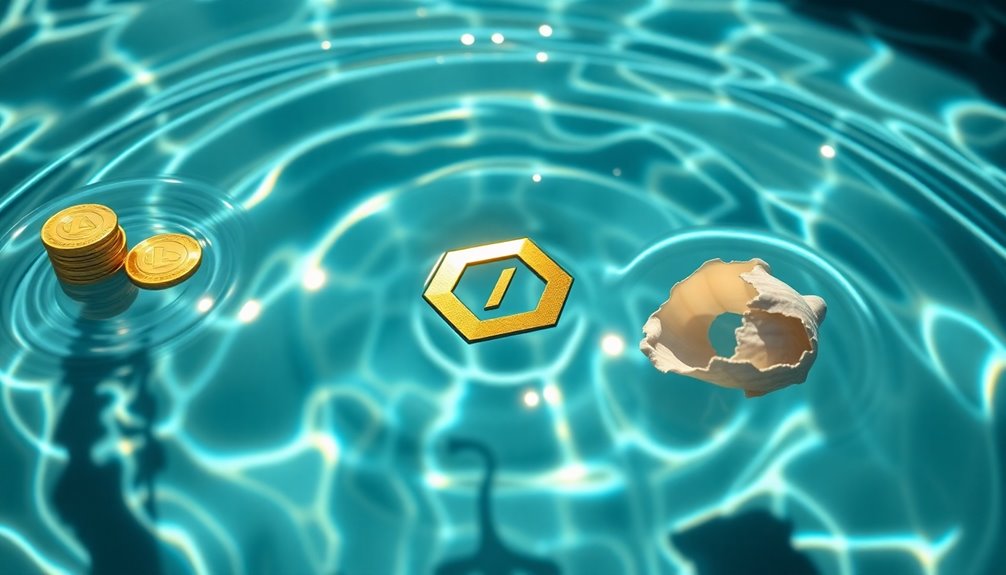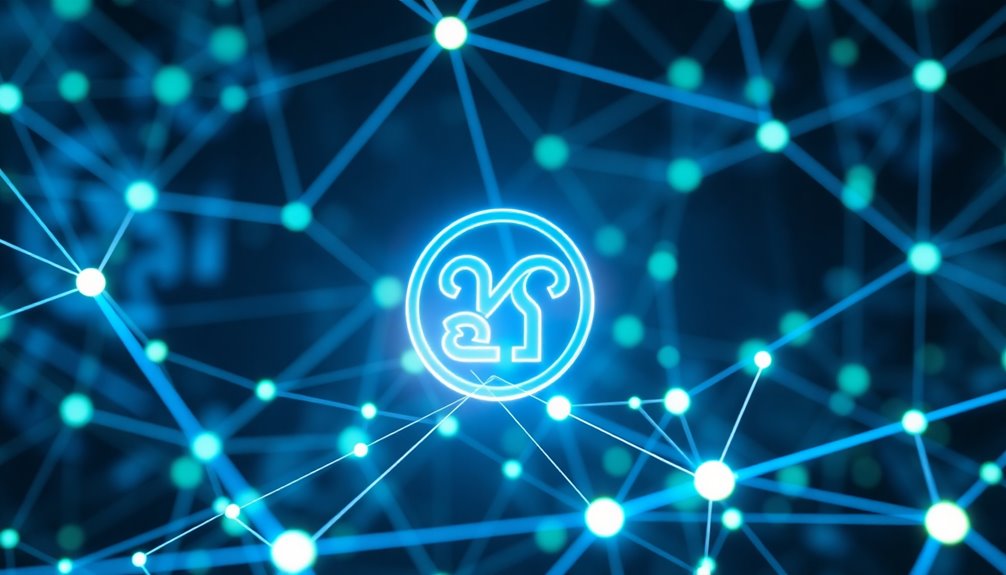If you're exploring QTum (QT), you'll find it stands out with its hybrid consensus, integrating both Proof-of-Work and Proof-of-Stake for robust security. The Abstract Account Layer enhances dApp performance by separating applications from the blockchain. With support for popular programming languages via its x86 Virtual Machine, creating smart contracts becomes more accessible. QTum also promotes decentralized governance, empowering you to participate in decision-making. While it offers unique advantages, it faces competition from established platforms like Ethereum. Keep going to discover more about its innovations and how they can benefit you in the blockchain space.
Key Takeaways
- QTum utilizes a hybrid consensus mechanism combining Proof-of-Work and Proof-of-Stake for enhanced security and decentralization.
- Its Abstract Account Layer separates applications from the blockchain, improving performance for decentralized applications (dApps).
- The x86 Virtual Machine supports smart contract development in popular programming languages like Rust, enhancing developer accessibility.
- The Mutualized Proof-of-Stake mechanism minimizes miner competition, promoting decentralization and reducing risks of network attacks.
- QTum's Decentralized Governance Protocol empowers token holders to participate in decision-making and protocol upgrades, fostering community engagement.
Core Features Overview

When exploring the core features of the QTum protocol, you'll find that it stands out due to its unique hybrid consensus mechanism. This combines Proof-of-Work (PoW) and Proof-of-Stake (PoS), enhancing security and decentralization.
The platform's Abstract Account Layer (AAL) separates applications from the blockchain, improving performance for decentralized applications (dApps). With support for the x86 Virtual Machine, you can create smart contracts using popular programming languages like Rust, broadening development options.
Additionally, the Mutualized Proof-of-Stake (MPoS) mechanism encourages user participation and stabilizes the network by reducing competition for resources.
Finally, the Qtum Decentralized Governance Protocol (DGP) empowers QTUM token holders to take part in decision-making, ensuring a more democratic governance process.
Qtum's Hybrid Blockchain Model

Qtum's hybrid blockchain model effectively combines Proof-of-Work (PoW) and Proof-of-Stake (PoS) mechanisms to enhance both security and scalability.
This innovative approach utilizes the Unspent Transaction Output (UTXO) model, reminiscent of Bitcoin, ensuring efficient transaction processing while supporting smart contracts via the Ethereum Virtual Machine (EVM).
By implementing the Abstract Account Layer (AAL), Qtum separates applications from the underlying protocol, boosting performance and simplifying the development of decentralized applications (dApps).
The Mutualized Proof-of-Stake (MPoS) mechanism minimizes competition among miners, promoting decentralization and reducing the risk of attacks or malicious contracts.
With robust development resources, Qtum provides a business-friendly environment that fosters innovation and accelerates the deployment of blockchain technology solutions.
Smart Contracts on Qtum

By leveraging the Ethereum Virtual Machine (EVM) and Bitcoin's UTXO model, smart contracts on Qtum offer a powerful blend of compatibility and efficiency.
This unique combination allows you to create decentralized applications (dApps) that can interact seamlessly with existing Ethereum contracts while benefiting from Bitcoin's robust transaction framework.
With the Abstract Account Layer (AAL), smart contracts are decoupled from the underlying blockchain, enhancing performance and scalability.
Plus, you can use the Rust programming language through Qtum's x86 Virtual Machine, making development familiar and efficient.
The Mutualized Proof-of-Stake (MPoS) mechanism fosters secure and efficient contract creation, minimizing risks in decentralized finance (DeFi) projects.
Qtum's governance model also enables real-time updates through smart contracts, ensuring community participation in blockchain evolution. Additionally, understanding investment regulations is crucial for anyone looking to navigate the complexities of decentralized finance effectively.
Pros and Cons Analysis

While examining the pros and cons of QTum, it's clear that its hybrid consensus mechanism provides a solid foundation for security and decentralization. You can earn passive income through staking rewards, making it an attractive option for those interested in decentralized finance (DeFi).
The Abstract Account Layer enhances flexibility and performance, allowing for scalable decentralized applications. Additionally, the Qtum Decentralized Governance Protocol encourages community engagement and smooth protocol upgrades.
However, QTum faces stiff competition from established platforms like Ethereum, which might deter some users. Plus, the complexities of staking and smart contract development can be off-putting for less knowledgeable individuals.
Lastly, while the diverse wallet ecosystem improves accessibility, user experience varies significantly, which could lead to frustration.
Qtum vs. Ethereum Capabilities

When comparing Qtum and Ethereum, it's essential to recognize the unique strengths each platform brings to the table.
Qtum combines the unspent transaction output model from Bitcoin with the Ethereum Virtual Machine, offering robust support for smart contracts while ensuring secure transactions. Its hybrid consensus mechanism of Proof-of-Work and Proof-of-Stake enhances scalability and reduces energy consumption, making it more environmentally friendly than Ethereum's original model.
Additionally, Qtum's Abstract Account Layer separates applications from the protocol, improving performance and developer experience. With a Decentralized Governance Protocol, token holders can propose and vote on changes, fostering community involvement.
Meanwhile, Qtum's staking mechanism allows users to earn rewards, integrating seamlessly into the growing decentralized finance (DeFi) ecosystem.
Regulatory Compliance Uncertainties

As Qtum continues to carve its niche alongside Ethereum, it encounters a complex web of regulatory compliance uncertainties. Each jurisdiction has its own take on classifying cryptocurrencies and blockchain networks, which complicates Qtum's compliance strategies.
With its hybrid governance model, Qtum aims to adapt to shifting regulations while promoting transparency and community involvement. However, its focus on enterprise solutions and decentralized applications (dApps) places it under increased scrutiny, especially regarding data protection and financial regulations.
As Qtum expands its decentralized finance (DeFi) initiatives, it may face challenges tied to securities laws, particularly around the issuance and trading of QTUM tokens. Engaging with regulators is crucial for establishing clarity and ensuring compliance within this evolving landscape.
DeFi Growth on Qtum

With the rise of decentralized finance (DeFi), Qtum is positioning itself as a key player in the blockchain ecosystem. The launch of the Qtum DeFi Incentive Program, offering $1 million in rewards, encourages innovation and development of dApps on its platform.
Qtum's unique hybrid blockchain combines Bitcoin's security with Ethereum's flexibility, enabling developers to create scalable DeFi solutions. The Mutualized Proof-of-Stake (MPoS) mechanism also incentivizes users to stake their QTUM tokens, enhancing network security and stability for DeFi projects.
Additionally, Qtum provides robust development resources, making it easy for developers to integrate DeFi applications using popular programming languages. Engaging with the community through the Qtum Decentralized Governance Protocol empowers users to earn and participate in shaping the ecosystem.
Utilize Qtum's Staking Rewards

By participating in Qtum's staking rewards, you can easily earn passive income while contributing to the network's security.
The staking mechanism operates on a three-part block reward structure, which includes rewards from transaction fees, making it an attractive option for those involved in decentralized finance (DeFi).
To get started, you only need a minimum of 1 QTUM token, ensuring accessibility for everyone.
As a staker, you'll join the Mutualized Proof-of-Stake (MPoS) system, which enhances security and minimizes competition.
Your rewards are distributed proportionally based on the number of staked tokens, so the more you stake, the higher your rewards.
With Qtum's diverse wallet ecosystem, managing your staked tokens is seamless and efficient.
Frequently Asked Questions
What Is the QTUM Protocol?
QTUM is a hybrid blockchain protocol that blends the advantages of Bitcoin's UTXO model with Ethereum's smart contracts.
It uses both Proof-of-Work and Proof-of-Stake mechanisms to enhance security and efficiency.
With its unique Abstract Account Layer, you can develop decentralized applications more easily.
The QTUM token plays a vital role in transactions and staking rewards, making it essential for anyone looking to engage with the QTUM network effectively.
What Blockchain Is QTUM Built On?
Qtum isn't built on a single blockchain; it combines elements from both Bitcoin and Ethereum.
By utilizing a hybrid approach, it incorporates the Unspent Transaction Output (UTXO) model for secure transactions while supporting smart contracts.
This unique structure allows you to benefit from the security of Proof-of-Work and the efficiency of Proof-of-Stake.
What Is the Circulating Supply of QTUM?
You might think the circulating supply of a cryptocurrency is static, but it's quite dynamic.
For QTUM, the circulating supply is about 96 million tokens out of an original 100 million. This number reflects the tokens distributed during its public sale and those allocated for team and community development.
Daily trading volumes exceeding $250 million show strong market activity, underscoring the importance of these circulating tokens in the ecosystem.
What Is the Usage of QTUM?
QTUM's usage revolves around its role as a medium of exchange on the Qtum blockchain. You can use QTUM tokens to pay transaction fees and interact with decentralized applications (dApps).
Additionally, by participating in the staking mechanism, you earn passive income from transaction fees and block rewards.
As a token holder, you also have the power to propose and vote on protocol changes, actively contributing to the network's governance and development.
Conclusion
In summary, Qtum's unique blend of blockchain technology and smart contracts positions it as a strong contender in the crypto space. With its focus on regulatory compliance and DeFi growth, there's plenty to explore. Are you ready to dive into the potential of staking rewards and harness the power of this innovative platform? By understanding Qtum's core features, you can make informed decisions and potentially benefit from its evolving ecosystem.









